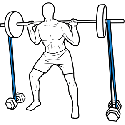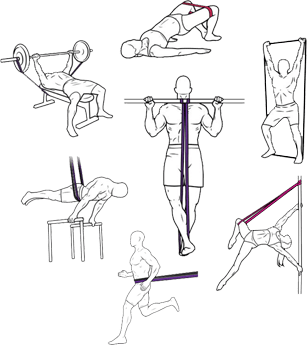Picture of Above of Frank Medrano
Hey everybody, hope you have your A-game flowing. Today we’ll be looking at calisthenics workouts that you can do with a home set up and limited equipment that will have you progressing towards some of the exercises you are likely working towards or are keen to develop. We’re going to break down various types of calisthenics exercises and add some context around the importance of each movement so you can logically layer your workouts.
To keep this simple, we will assume that you have the following bodyweight training equipment for your calisthenics workout routine. The same equipment pertains to everyone, regardless if you are a beginner or advanced athlete, so rest assured that your bodyweight training gym equipment will never become obsolete.
Check out our calisthenics kit for every band you need to complete your routine!
-
A combo calisthenics band set that includes at least a couple different resistances. These contribute to your workouts by adding resistance (making pulling or pushing harder) when needed as well as adding assistance (making pulling or pushing easier).
-
A set of push up bar grips or a set of parallettes. These are your best friends for training L-sits, I-sits, planche, handstand, deep pushups, modified dips.
-
A set of gymnastic rings. Excelling training tool for mastering textbook technique on pullups, muscle ups, dips, and many others.
-
A Pull Up Bar. This removable pull-up bar doubles as a pull-up bar, dip bar, and crunch bar.
I’ve kept it simple here because these four are inexpensive, effective and all you need to build functional strength throughout your entire body -- when combined with a little effort and consistent training. Before I take you into the workout, there are a couple of things we should make clear. The first thing we should clarify is the purpose of training – which is to progress and improve at what you are doing over time. To ensure this occurs, you need to be aware of, at the bare minimum, 3 things.
To progress you must:
-
Train consistently (yes, this goes without saying, but people still somehow forget this). For the sake of argument, we suggest working out with your calisthenics workout equipment at least three days per week, or at a minimum, incorporating pull-ups, dips, and pushups into your normal workout schedule. These three exercises are the pillars upon which most calisthenics movements are built upon.
-
Train specifically- that means if you want more chin-ups, squats aren’t going to get you there. The best way to increase your pull-ups is to do pull-ups : ) If you have a hard time doing more than a pullup or two right now, then use our pull-up bands to ratchet up the amount of assisted pull-ups you can do. As you get stronger then progress forward by using a thinner band.
-
Progressively overload- that means one more repetition or a couple more pounds resistance next time you train, and the time after that. You have to push yourself a little harder each time to make consistent gains. There are different ways to increase the intensity of your workout. For example, you can add more resistance to your exercises, or you can perform more reps and/or sets at the same resistance, or you can make modifications to make exercises harder (such as wide grip vs narrow grip), or you can reduce the rest time between sets.
Now that we are clear on what is required to progress, let’s have a deeper look under the hood at what focused training means for calisthenics?
Well, calisthenics at a competitive level is often partitioned into dynamic and static movements that competitors combine in order to create a sequence [or ‘a flow’] on the bars. To train specifically for dynamic movements, we need a tremendous amount of explosive pulling strength, which is where our rings and pull up bar come in handy. This explosive pulling strength is what will allow us to perform muscle ups and dynamic moves that stem from being above the bar. I recommend having both rings and the pull-up bar here because the bar is specific to calisthenics where the rings are not seen often competitively often, but more as a gymnastics training tool. Gymnastics rings are a valuable tool that one can use for breaking down movement patterns and building functional strength throughout the entire upper body.
Alternatively, we see static ‘movements’ pepper the calisthenics landscape as well. Here we are talking about planches, handstands, and levers of various sorts. For planches and handstands, the parallettes will be your go-to tool for training, along with the good, old floor. This will establish the strong base of pushing strength that we likely miss in the explosive pulling associated with dynamic elements of calisthenics.
Let’s not forget about the resistance bands, which allow us to scale our workouts and provide us with assistance where necessary. Exercise bands are also quite handy for training legs, which although this is not a standard calisthenics progression, it is still highly recommended for a healthy and high-performing body. It is also important to remember this as none of us are likely calisthenic gold medallists in-the-making, but people looking to be stronger, healthier and happier (and trust me, training legs, contrary to popular belief will make you these things!).
The calisthenics movement is bifurcated into two subcategories; there are the competitions and the workouts. The training modality is commonly referred to as ‘street workout’ on an international basis but known widely in the United States as simply ‘calisthenics’. Calisthenics competitions, which are typically staged as ‘battles’ pit two competitors against each other in a tournament or round-robin style event. Athletes are then judged based on criteria including strength, difficulty, grace, creativity, and swag… gotta look good on the bars!
Calisthenics is also hugely popular in Russia and throughout the Eastern Bloc. Static movements that are a testament to the athlete’s strength tend to be more highly regarded in the East than they do in the West, though not always true.
Here is an example of what one of the international calisthenics battles that we sponsor looks like:
Ok, so now we’ve clarified what training needs to progress, and how we are going to train (mostly) specifically to calisthenics to ensure we progress in the way we desire. Now let’s take a look at the workouts and how to structure them. Below you’ll find a recommended training regimen that one of our seasoned calisthenics trainers (Joel Mullen) created for your consumption and gains:
Day 1:
A1- Horizontal Push Up Variation: 5-8 repetitions, 3 sets
(Elevated Pushup, Knee Pushup, Pushup, Weighted/Banded Pushup).
View On Dropbox: variations.mp4
A2- Squat Variation: 10-12 total repetitions, 3 sets
(Backwards lunge, Bodyweight squat, Bulgarian Split Squat, Shrimp Squat, Banded squats)
View On Dropbox: Squat variation.mp4
B1- Pull Up Variation: 4-7 repetitions, 3 sets
(Elevated Row, Tabletop Row, Inverted/Ring Row, Feet Assisted Pull Up, Chin Up, Pull Up, Weighted/Banded Pull Up)
View on Dropbox: Pull up progressions.mp
B2- Wall Handstand Tuck Lean Extend: 30-60s, 3 sets
View on Dropbox: Handstand tuck clean extend.mp4
C1- Dive Bomber Push Up Variation: 5-12 repetitions, 3 sets
(Up-down dog, Half Dive Bomber, Full Dive Bomber)
View on Dropbox: Dive bomber variation.mp4
C2- Pistol Leg Lifts: 6-12 repetitions per side, 3 sets
View on Dropbox Dive bomber variation.mp4
D1- Banded Face Pulls: 10-15 repetitions, 3 sets
D2- Lateral Cossacks: 3-5 repetitions each direction, 3 sets
View on Dropbox: project042.mp4
D3- Curl Ups/Reverse Sit Ups: 6-10 repetitions, 3 sets
Day 2:
A1- Front Lever Pulls Progression: 5-15 seconds/3-8 repetitions, 3 sets
(Inverted Hang, Feet to the bar, Negative pull, 90-degree negative pull, 90-degree positive pull, Tuck Front Lever pull).
VIew on Dropbox: Front lever pull progression.mp4
A2- Banded Romanian Deadlifts: 6-8 repetitions each side, 3 sets
View on Dropbox: Banded Ordls.mp4
C1- Chest to Wall Handstand: 40+ seconds, 3 sets
View on Dropbox: Chest to wall hs.mp4
B2- Pull up Progression: 10-15 repetitions, 3 sets
(Elevated Row, Tabletop Row, Inverted/Ring Row, Feet elevated ring row)
View on Dropbox: Pull up progressions.mp4
C1- Push Up Variation: 5-8 repetitions, 3 sets
(Elevated Pushup, Knee Pushup, Pushup, Weighted/Banded Pushup).
View on Dropbox: Push up variations.mp4
C2- Hollow body progression: 30+ seconds, 3 sets
(Inverted Hang, Feet to the bar, Negative pull, 90-degree negative pull, 90-degree positive pull, Tuck back Lever pull).
View on Dropbox: Hollowbody variations.mp4
D1- Banded Shoulder dislocates: 10-15 repetitions, 3 sets
View on Dropbox: Dislocates.mp4
D2- Twisted Tabletop: 5 each side, 3 sets
View on Dropbox: Tabletop HT.mp4
D3- Tabletop Hip Thrust: 8-12 each side, 3 sets
View on Dropbox: Tabletop HT.mp4
Day 3:
A1- L-sit raise and lean: 3-5 repetitions each side w/ 3s+ hold each repetition, 3 sets
View on Dropbox: Lsit raise and clean.mp4
A2- Pseudo-planche push up (/Banded tuck planche lean) progression: 4-8 repetitions, 3 sets
View on Dropbox: Planche leans.mp4
B1- Elevated Squat Variation: 3-5 repetitions each side, 3 sets
View on Dropbox: Elevated squat.mp4
B2- Handstand Heel Pulls: 3+ repetitions, 3 sets
View on Dropbox: Heel pulls.mp4
C1- Suspended hamstring curl: 6+ repetitions
View on Dropbox: Suspended hamstring curl.mp4
C2- Slow Deck Squat: 10+ repetitions
View on Dropbox: Slow Deck Squat.mp4
D1- Up/down dog: 5 repetitions
D3- Squat to stand: 8 repetitions
These 3 days will form an easy base to your calisthenics workout plan that will allow you to advance towards early planche progressions, handstand progressions and front lever progressions. They also help develop explosive pulling strength for any dynamic exercise you wish to endeavor upon on in the future. Who wants to do 10 unassisted muscle ups (raise your hand in your head)?
From here, there are many places and programs online that will allow you to develop further from this stable base, including the ebooks Rubberbanditz have for sale in the Calisthenics section. Another thing to consider is using parallettes to add depth or height to the push-up variations – the deeper you go the more muscle engagement you will feel.
Thanks for loaning us your eyes. We hope you’ve picked up some valuable titbits to help accelerate your training. Have a look at our Instagram page @rubberbanditz for additional training ideas on how to use your RubberBanditz calisthenics equipment. Also, let us know if you have any questions or need additional clarification.




